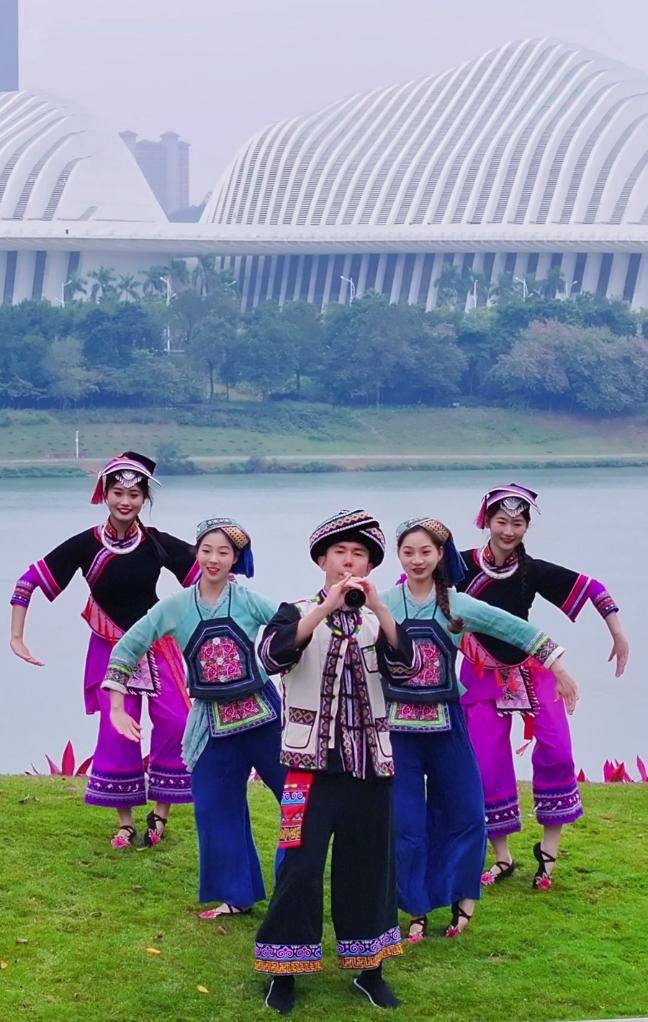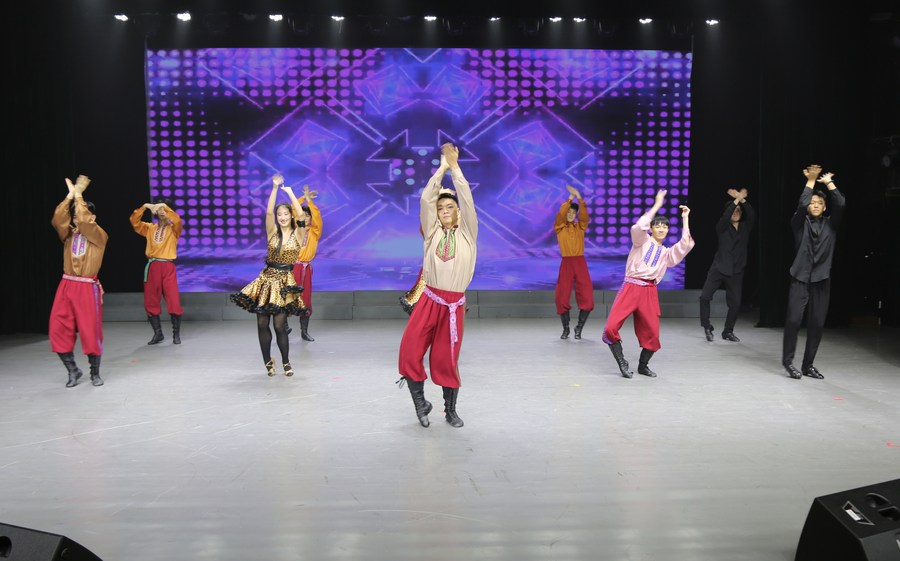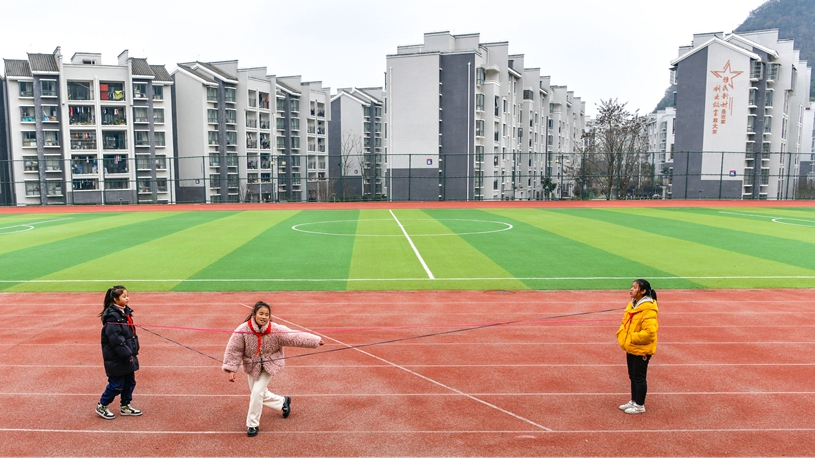* The "Kemusan" dance, translated as "Subject Three" dance, has become the latest internet hit in China.
* Dancing is an expression of personality and intense emotions that young people identify with, and because of the viral nature of social media, "Kemusan" quickly overwhelmed the youth community.
* The viral trend of "Kemusan" represents a preference for personal and emotive expressions over regularity and high-sounding narratives, as well as an emphasis on personality.
NANNING, Dec. 27 (Xinhua) -- People spring into a freestyle street dance to the pulsating rhythm of an upbeat Chinese song, swinging their knees and ankles sideways while performing dazzling hand moves, including rapid wrist-twisting actions.
This so-called "Kemusan" dance, translated as "Subject Three" dance, has become the latest internet hit in China. Social media platforms have been overwhelmed with user-generated video clips of men and women, professional and amateur dancers, Chinese and foreigners, performing the "Subject Three" dance moves in diverse circumstances.
The captivating dance, along with its fun and spontaneous moves, has brought tremendous joy to young Chinese viewers. If that is not enough, the new dance is also popular among foreigners. However, like any other internet hit, "Kemusan" was not without controversy.
WHAT IS THE "KEMUSAN" DANCE
The infectious "Kemusan" music echoed in a street dance training studio in Nanning, the capital city of south China's Guangxi Zhuang Autonomous Region. Guo Siyuan, the dance studio teacher, told Xinhua that some students requested a training session dedicated to the "Kemusan" dance.

This screenshot captured from a video shows people learning "Kemusan" dance at a street dance training studio in Nanning, south China's Guangxi Zhuang Autonomous Region, Dec. 20, 2023. (Xinhua/Huang Kaiying)
"'Kemusan' is quite popular," Guo said. "However, it is not easy to dance it well as many of its moves originate from breakdance."
The "Kemusan" dance routine was widely believed to originate from a dance created and performed by a wedding guest from Guangxi more than two years ago.
As to why it was named "Kemusan," a shortened name that originally referred to the third-subject test or the road test required to obtain a driver's license in China. Story has it that an excited test-taker once danced it to celebrate his triumph after passing the road test. When curious bystanders inquired about the name of the dance, he responded with an off-the-cuff answer, "Subject Three."
Another explanation pays tribute to Guangxi, a provincial-level region with a large multi-ethnic population from where the dance originated. It is understood that everyone born in Guangxi is subject to three tests in their lives: singing folk songs, eating rice noodles, and dancing.

This screenshot captured from a video shows people performing "Kemusan" dance with traditional musical instruments of the Zhuang ethnic group in Nanning, south China's Guangxi Zhuang Autonomous Region, in December 2023. (Xinhua)
HOW AND WHY HAS IT GONE VIRAL
The dance has gained popularity in bars before making its way to Douyin, a popular short-video platform, with its enticing hashtag "Kemusan." It subsequently became an instant hit among young people both online and offline, fueling a wave of dance challenges, which was joined by celebrities and business owners eyeing the fan base and commercial prospects behind this dance craze.
In November, video clips showing employees of Haidilao, a hot-pot chain, repeatedly dancing "Kemusan" to entertain customers made it to the internet's hottest-trending topics.
"Kemusan" has even gained overseas fans, with videos of the dance routine being widely viewed on YouTube and Twitter. The performance of "Kemusan" by foreign professional dancers as an encore has sparked a new social media frenzy among young Chinese internet users.
The 2023 WDSF GrandSlam Final Latin winners from Germany, Khrystyna Moshenska and Marius-Andrei Balan, performed "Kemusan" following their competition in the final held in Shanghai. After a Swan Lake performance in China's Liaoning Province, dancers from a Russian Ballet troupe took a curtain call and sprung into the "Kemusan" dance.
"I saw many video clips showing professionals dancing 'Kemusan,' including international dancing stars," said Zhang Jiajia, a Nanning local who is learning the dance routine. "By dancing it myself, I feel like being drawn closer to them."

Students from Guangxi Arts University perform "Kemusan" dance during a campus activity in Nanning, south China's Guangxi Zhuang Autonomous Region, Dec. 20, 2023. (Xinhua)
Dancing is an expression of personality and intense emotions that young people identify with, and because of the viral nature of social media, "Kemusan" quickly overwhelmed the youth community, said Zhang Tieyun, associate professor at the School of Journalism and New Media, Xi'an Jiaotong University.
Zhang also mentioned a paradigm shift in which people gravitate toward unique and pleasant day-to-day expressions.
The viral trend of "Kemusan," according to Zhang, represents a preference for personal and emotive expressions over regularity and high-sounding narratives, as well as an emphasis on personality.
Some people, however, think the dance routine is "tacky." Proponents, on the other hand, argue that "Kemusan," even though not elegant or sophisticated, let alone classy, was created and widely watched and performed by ordinary people, making it viral and even gaining international recognition. This discussion has only fostered the trend going viral.
"I was delighted to see that 'Kemusan' is going global, and people from other countries liked our culture, music and dances," said Chen Ying, a local from Guangzhou, south China's Guangdong Province, adding that the younger generation in China is becoming increasingly confident and outgoing, and "Kemusan" may just herald a future where a popular Chinese culture is increasingly seen on the world stage.
(Reporting by Tian Ying, Pan Qiang, Zhu Lili, Huang Kaiying; Video reporters: Qin Guanghua, Zhu Lili, Huang Kaiying; Video editors: Zhang Nan, Liu Xiaorui, Zhou Yang, Liu Ruoshi and Liu Yutian). ■












